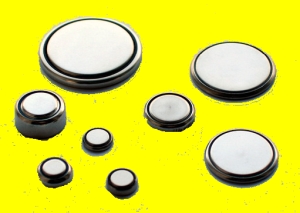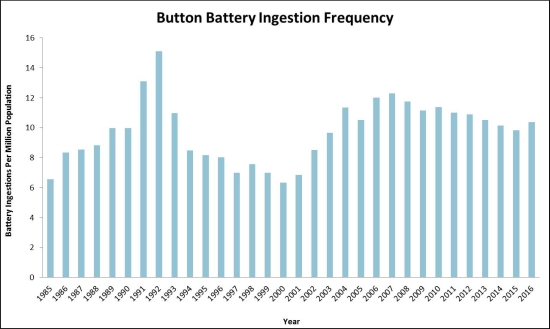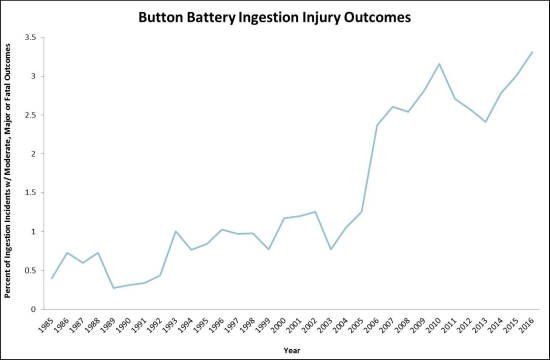Keith Rhoades, Intertek Group PLC
Worldwide, more than 5 billion button and coin-cell batteries are produced every year. In addition to containing a lot of power in a small package, these batteries also introduce potential hazards, particularly to children and the elderly. More than 3,500 incidents of button and coin cell battery ingestion are reported each year, according to data from the American Academy of Pediatrics.
The ingestion of one of these batteries can bring minor complications or more serious injury and even death. The industry is now responding to this risk, and product designers now can take steps aimed at heading off such difficulties.
 Coin and button cell batteries range in size from 3/16 in. to 1¼ in.; they’re also inexpensive and can be more energy-dense than traditional cylindrical batteries. The higher energy density means these buttons have a longer shelf life, making them candidates for products that require a lot of power for an extended period of time.
Coin and button cell batteries range in size from 3/16 in. to 1¼ in.; they’re also inexpensive and can be more energy-dense than traditional cylindrical batteries. The higher energy density means these buttons have a longer shelf life, making them candidates for products that require a lot of power for an extended period of time.
Because of their size, button and coin cell batteries present a choking hazard for small children, as they are larger than the esophagus of an infant or toddler. What’s more, when these batteries get stuck in places like the throat, nose or ears (where children are also prone to insert them), they can lead to severe burns.
These batteries, when activated, create a strong electrical discharge due to the proximity and size of the battery terminals. The current generated breaks down with water, producing hydroxide. The hydroxide can lead to caustic injury to tissues, damaging the esophagus, trachea, blood vessels, vocal chords, ear canals, nasal cavities and more. Serious damage can happen within hours of ingestion.
 While these hazards exist for everyone, there are two key groups most at risk for ingestion of and injury from button and coin cell batteries—children up to the age of 5 (but particularly infants and toddlers under the age of 3) and the elderly.
While these hazards exist for everyone, there are two key groups most at risk for ingestion of and injury from button and coin cell batteries—children up to the age of 5 (but particularly infants and toddlers under the age of 3) and the elderly.
Babies and toddlers put things in their mouths. This is a typical stage of development and exploration referred to as “mouthing.” Children mouth for a variety of reasons—self soothing, exploration of the world around them, teething—and it can be quite prevalent through the age of 3, but continues throughout childhood. For a young child who is exploring the world through all five senses, including touch and taste, a small, smooth, shiny object like a button or coin cell battery can be irresistible.
Given their size in relation to the size of a typical child’s esophagus, it is quite common for button or coin cell batteries to become lodged in the throat if swallowed, presenting a choking hazard to children under the age of three. If the button or coin cell battery passes through the esophagus to the stomach, it will neutralize and is likely to pass through the digestive system. However, even after the age of three, injuries can arise as it is still possible to have a battery become lodged in the body, resulting in caustic burns.
If the battery becomes lodged in the throat, nose, ear or other cavity, the battery current begins to react with the saliva or mucosa, causing burns and other damage to the tissue. However, after children reach five years of age, ingestion and potential injury drops dramatically given that they are less likely to put things in their mouth, noses or ears and because their esophagi are larger. After this age there are slight upticks in battery ingestion with adolescents—largely attributed to stereotypical adolescent behavior—and the elderly.
 For the elderly population, it is thought that a combination of diminished eyesight, increased quantities of medication and the use of these batteries in both common household items and medical devices like hearing aids, are responsible for a rise in ingestion and injury. Batteries may get mixed in with pills and consumed, leading to injury.
For the elderly population, it is thought that a combination of diminished eyesight, increased quantities of medication and the use of these batteries in both common household items and medical devices like hearing aids, are responsible for a rise in ingestion and injury. Batteries may get mixed in with pills and consumed, leading to injury.
One factor that can make ingestion worse is that often a parent or caregiver is unaware that a battery has been consumed. To further add to the uncertainty, as the battery begins to break down, the symptoms an individual would exhibit—coughing, wheezing, vomiting, fever, irritability or listlessness—could be mistaken for something else.
Additionally, once a medical professional removes the battery, the injury is not always over, as the caustic hydroxide ion is still present on the tissue and injury can continue. Often a patient is sent home from the emergency room after a battery is extracted, only to return days later with further injury as the chemical reaction has continued and worsened.
The injury is relatively easy to control with the application of an acid, such as vinegar or lemon juice, to counteract the base chemical reaction occurring. Consuming sodas and sports drinks, also acidic liquids, have also shown a positive correlation in regards to reduction of prolonged injury. Though the injury can be controlled and treated, it is real and, as such, the industry has responded to the risks associated with these batteries.
The Industry Responds
The rising number of injuries related to button and coin cell batteries brought professionals together to form the Button Battery Task Force. It is comprised of members from the medical community, battery manufacturers, academia, regulatory bodies and independent third-party testing laboratories. (It should be noted here that I am a member of the task force, representing my employer, Intertek.)
The Button Battery Task Force considers several factors regarding button and coin cell battery injuries, including prevention, treatment, education and awareness. Members of the group have undertaken studies on packaging and product design. Others focus on educating medical professionals on how to identify and treat battery ingestion cases. Much of the work Intertek has been involved in includes injury research and novel means of mitigation. As a result of the collaborative effort, outputs from the research have improved the emergency response process as well as operating room procedures. The task force also works closely with the National Poison Control Center on what to tell callers dealing with battery ingestion concerns, including instructions to go to the hospital and potential ways to neutralize the reaction while waiting for medical assistance.
Much of the work done by members of the task force has been translated into action across several industries to help reduce risk and better treat injuries. To that end, there are several things manufacturers of batteries and battery powered products can do to better mitigate risks associated with button and coin cell batteries.
Easing the risks of button and coin cell battery ingestion and injury can best be summed up with a three-step approach: eliminate, reduce, warn. Manufacturers of both products and batteries can work to eliminate the risk of ingestion by implementing best-practices around the design of products themselves and battery packaging. Measures are taken to reduce the potential of battery ingestion or injury for children or the elderly. Manufacturers can also take steps to help warn consumers about the hazards of battery ingestion in the hopes of preventing it.
By far, the most preferable method to mitigate risks is to eliminate them. Product design can play an extremely important role in eliminating risk. Products that don’t break are less like to lose batteries. More specifically, design specifications that better entrap the batteries in the compartment can make a significant difference. Protecting the negative side of the battery, say with plastic, can help make sure the batteries don’t become lose or discharge should the compartment become ingested. This small, fairly inexpensive step can make a world of difference in helping to protect consumers.
For electronic products, design specifications can also reduce risk by diminishing the chances of a battery coming loose or dislodging. Using more than one technique to secure the battery door greatly reduces the risk of batteries coming free and being ingested. As such, incorporating two or more redundant systems to contain the battery — such as a snap lock and a screw — is a design concept that is becoming more common. It is even required in some countries, like Australia.
Battery manufacturers can also use design to reduce risks by employing child-resistant packaging. In essence, the more difficult it is to open the package, the better. Consider resistance factors and a multi-step process that requires a tool, like scissors. A better balance of function and safety can make a huge difference. Another design element manufacturers can use is an indicator on the battery that shows up on an X-ray, which will allow medical personnel to recognize the patient has consumed a button or coin cell battery and not another small object, like a coin itself. Medics can then recognize the urgency of removing the item and fast-track the victim to an operating room or necessary facility for removal.
While battery manufacturers can’t eliminate exposure to batteries, they can employ some means of eliminating the risk of injury by putting a sticker over the negative side of the battery. This barrier will prevent the battery from discharging an electric current, so it will do less harm if it is ingested.
Product manufacturers must include safety information on packaging and in product manuals. So it makes sense to include information on the risk of battery ingestion and injury and recommendations to mitigate risk, such as disposing of used batteries immediately or storing batteries safely. Continued research collaborating with members of the task force include new methods of disposal. Something as simple as wrapping used batteries with, say, tape, may be enough to discourage children from playing with them as well as mitigate potential ingestion hazards.
Battery manufacturers, too, can include instructions about storage and warnings about ingestion on their packaging. More importantly, stickers used to render the battery safe can include “do not consume” language to help warn against the dangers and help manage the risk. Illustrative warnings may also be necessary to communicate the harm to children; however, this approach comes with a warning itself. Uneducated consumers may interpret the image as something to do, and even encourage the consumer or user to ingest!
All in all, implementing design methods and following industry developments can let manufacturers make a small investment upfront to reduce future costs associated with fees, recalls, redesigns and reputational damage. Investing in these steps now can mean great peace-of-mind for manufacturers, designers, retailers and consumers in the long run.
References
MIT News. “New Way to Make Batteries Safer.”
American Academy of Pediatrics. “Button Battery Task Force.
Jatana, K. et al. Basic Mechanism of Button Battery Ingestion Injuries and Novel Mitigation Strategies After Diagnosis and Removal. The Laryngoscope. Vol 127, Issue 6. Pages 1276-1282.


Leave a Reply